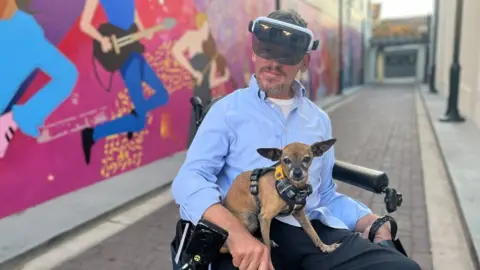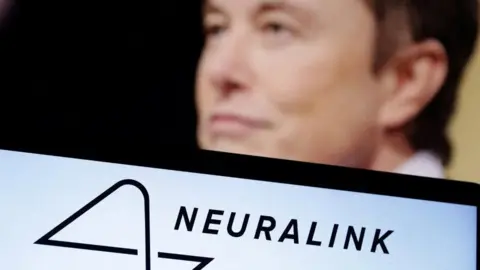‘My name is Chris’: The tech turning thoughts into speech
18 December 2024

As the potential for surgically installed brain implants hots up, could a new type of non-invasive wearable technology, which turns thoughts into speech, be a more simple way to support people with communication challenges? Gus Alexiou finds out.
Chris Benedict, 41, DJs at clubs and events across Santa Barbara, USA, under the name DJ of Ability.
When it comes to gigs, he has a crew to help him unload the van and get him set-up, but getting the crowd going in a loud environment can prove tricky.
Chris has cerebral palsy. His speech is impaired and he uses a motorized wheelchair.
“People often struggle with what I am trying to communicate,” he says. “This is a barrier that makes daily life difficult.”
At times, he finds himself going on long descriptive journeys to get his point across because he finds certain words, like “chocolate” difficult to say. “As you can imagine, this can be time-consuming, frustrating and exhausting.”
Chris’s frustration is a problem technology company Cognixion is hoping to solve.
The California-based venture has created a head-worn device called the Cognixion ONE which comes with a visor and looks like a virtual reality (VR) headset. It displays pre-set commands on the inside of the visor such as: “Please can I have a cup of coffee?” or “My name is Chris”.
The wearer fixates on the command they want and six electrodes, attached to the headset, read the users visual cortex brainwaves and determine which command they want. Once selected, it is then voiced electronically or appears as text running across the visor.

It is different to eyegaze technology because there are no cameras or eye-tracking involved and can help reduce the fatigue some might find in holding their eyes still to keep a cursor or pointer on a single icon.
Spontaneous sentences can also be composed at a rate of about 30 words per minute. This may not be lightning fast, given that it is four times slower than broadcast speech, but the designers say it is adequate for a basic conversation and to be understood by others.
Cognixion’s CEO, Andreas Forsland, says: “It’s all about the power of conversation.
“Once someone can have a simple conversation, all kinds of opportunities open up. You can develop friendships, you can answer questions, you can have more independence or just go buy a coffee.”
As well as human-to-human communication, the technology can integrate with Amazon Alexa to complete programmed household tasks, such as turning the lights on.
Andreas says: “Imagine someone who’s unable to communicate but entirely cognitively intact. What we’ve had to think about is how we can help people bypass their body, bypass the meat and the nervous system and get right to the outcomes by controlling things through mental fixation.”
Chris has been one of the first people to try the Cognixion ONE at its prototype stage.
“Being able to connect with those around me immediately, without any delay, makes it like I’m not locked in when I can’t get the words out,” he says. “And there is no guessing about what I’m trying to say. I feel truly heard.”

As well as his space exploration and electric vehicles, tech tycoon Elon Musk has another side hustle – Neuralink – a company looking at the feasibility of implanting probes directly into the human brain to allow for wireless communication with devices such as phones and computers.
Musk views the meshing of brain and machine as a vital component in ensuring human supremacy over rapidly evolving AI technology and believes that one day, his pioneering brain implants will be as commonplace as owning an iPhone.
For people living with physical and communication difficulties these ambitions open up a world of possibilities such as controlling robotic limbs to driving mobility devices through the power of thought alone.
But Dr. Tom Chau, based at the Holland Bloomview Kids Rehabilitation Hospital in Toronto and a specialist in communication disorders offers a word of caution. He believes there are more advantages with the wearable versions and their implantable counterparts could be a step too far.
“Implant procedures carry a risk of infection, haemorrhage, and tissue injury,” he says. “There are reports of degraded signal quality over time from implanted devices and hence a subsequent surgery may be required.”
In contrast, he says the wearable systems, like the one Chris is trialling, come with advantages.
“For one, users are no longer tethered to a computer display and are thus free to move through their environment.”
US telecommunications giant Verizon has already spotted the Cognixion ONE’s potential. It has bought the assisted reality start-up into its Forward For Good team which works with socially conscious start-ups.
It is hoped the device will be available to consumers by the end of 2025, subject to the Food and Drug Administration’s (FDA) approval which, in turn, has agreed to fast-track the process.
For Chris, the technology’s potential is tantalizing. Used to socialising and loud clubs, he says it has made his working life easier and made “all my interactions more enjoyable rather than a basic conversation being taxing and frustrating”.
He says: “I can connect with my crowd better. Plus, it looks super cool and is something I actually want to use when I’m out and about.”